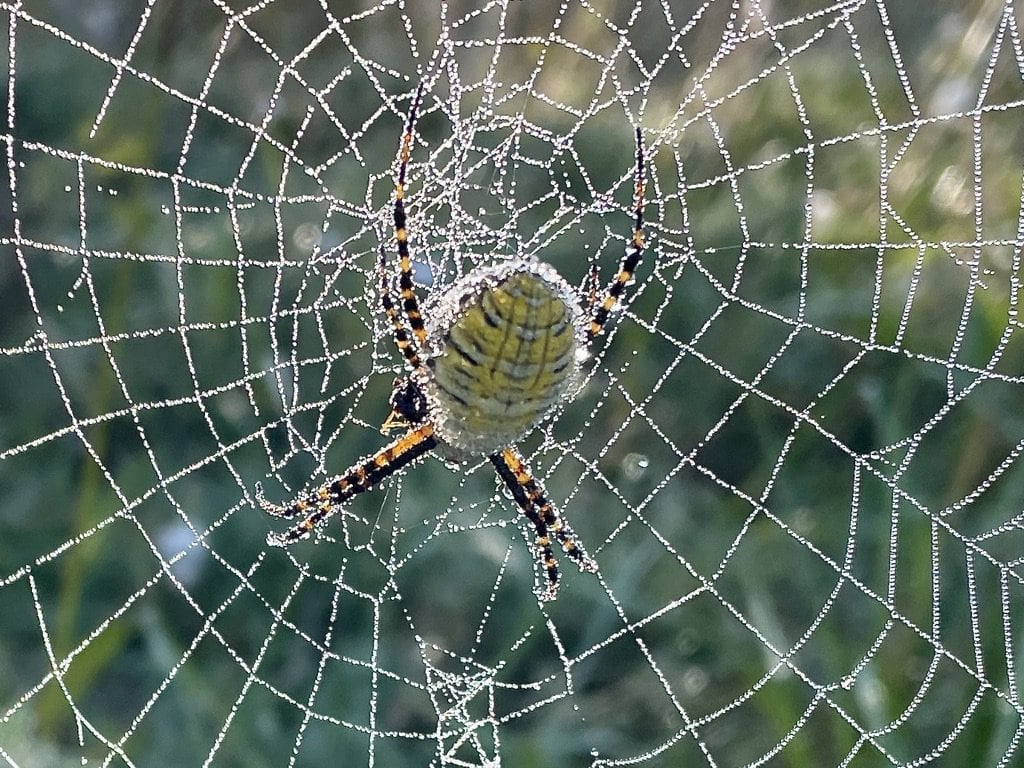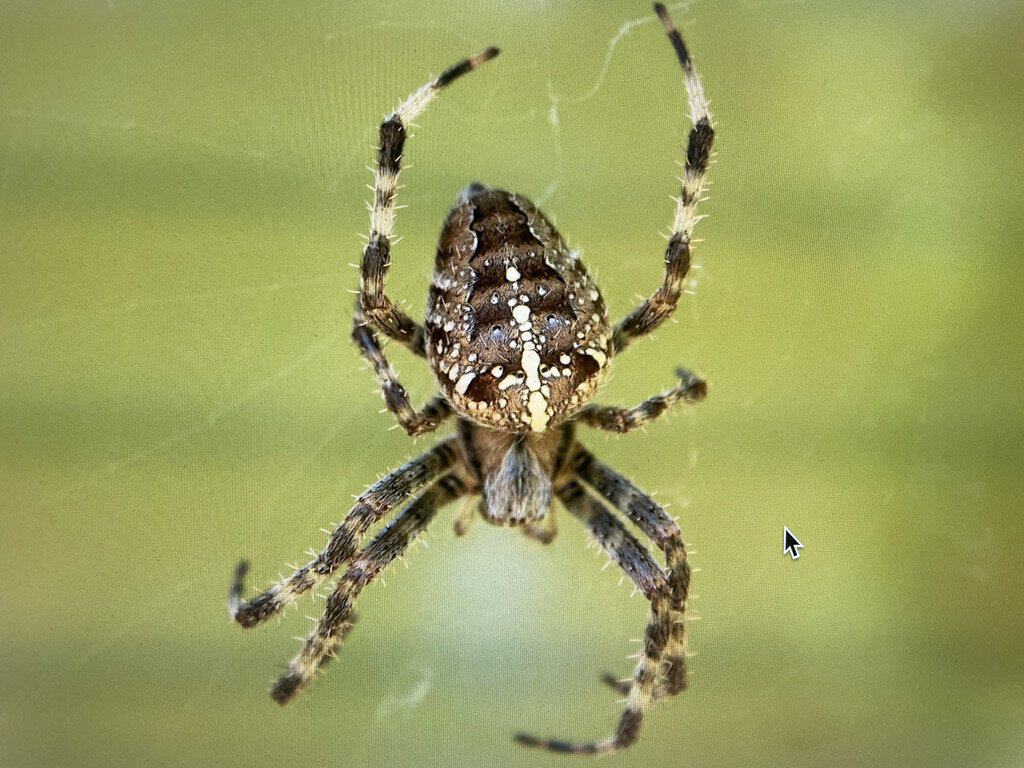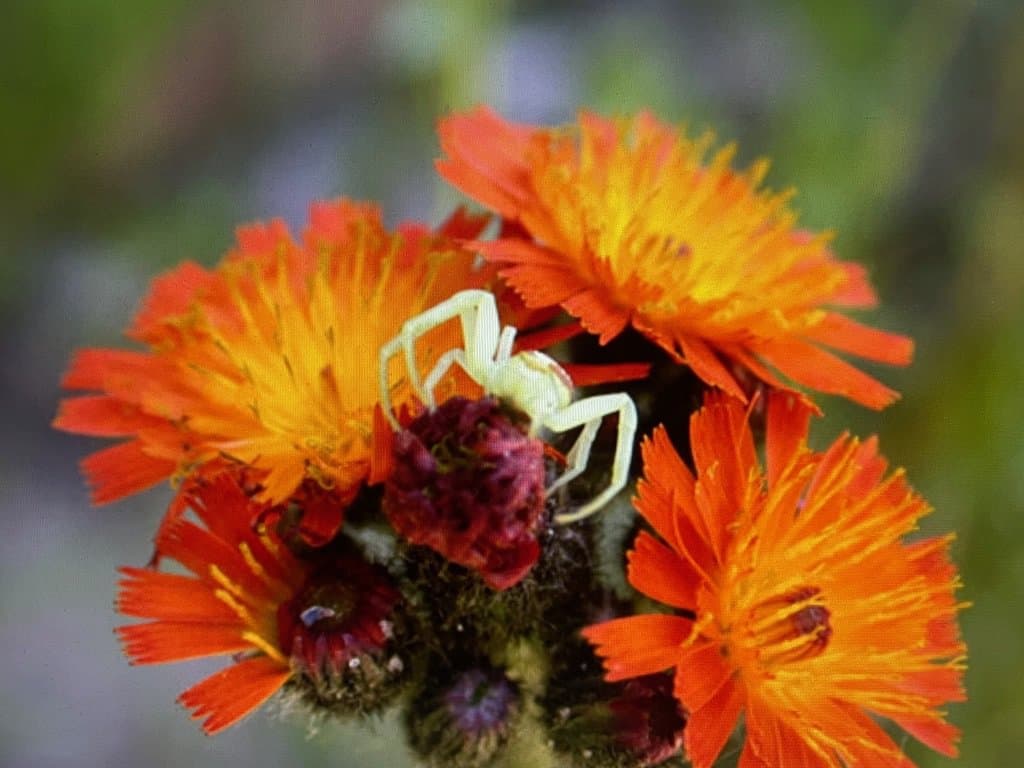Spiders are fascinating creatures and an essential part of our local biodiversity
Peterborough Examiner – August 23, 2024 – by Drew Monkman
Late summer is a special time of year. Dawn often arrives with heavy dews, gentle mists and a sort of melancholy peace as fall approaches. It’s on these quiet beginnings to the day that the interaction of early morning sunlight and lingering dew can reveal dozens if not hundreds of spider webs. But, if you’re anything like most people, your knowledge of these enigmatic creatures may be limited.
Spiders are carnivores belonging to the class Arachnida, which also includes scorpions, mites, ticks and harvestmen (daddy longlegs). In fact, spiders represent the largest group of animals in the world made up exclusively of predators—all spiders kill and eat other animals for food.
Unlike insects which have three body parts and three pairs of legs, a spider’s body is divided into two parts – the abdomen and the cephalothorax – and four pairs of legs are present. All spiders produce a venom with which they subdue their prey. The chemical concoction is injected through the tips of their jaws. A powerful “pump” in the abdomen then allows the spider to suck up the body fluids of the catch. Spiders never actually ingest solid flesh but only the nutritious body fluids.
Very few spiders are poisonous to humans. The only native species in Ontario that can be dangerous is the northern black widow. Fortunately, it is very rare here, extremely secretive and docile. Only a few cases of people being bitten have ever been recorded in Ontario.
Peterborough County is home to hundreds of species of spiders of many different families. Identification, however, is a tricky business. In many families, only mature males can be confidently identified to the species level. Even then, it’s often necessary to observe them under magnification.

Spider silk
Without a doubt, the main claim to fame of spiders is their ability to spin and fashion silk. This is probably the key to their success as such an abundant and diverse group of organisms. Spider silk is a unique protein that combines amazing strength and elasticity. It emerges from three pairs of “spinnerets”, located at the hind end of the abdomen and connected to several types of glands. Each type produces a different variety of silk, depending on the need.
Spiders use silk as a personal springy safety line; a tough, heavy suspension cable for the web; a sticky “tanglefoot” to catch insects; a straight-jacket for immobilizing prey; a long parachute to float through the air; and as a waterproof egg case. Spider silk is also an excellent transistor of vibrations. Through its eight legs, a spider can instantly interpret the vibrations and tell not only where in the web the insect has become entangled but whether it is a suitable prey.
Orb and funnel weavers
Probably the most noticeable webs at this time of year are those of a family known as the orb weavers. These are the classic, vertical webs attached to plants, branches, buildings and fences. On early morning walks, I often see hundreds of these webs, especially in brushy, damp fields. The rays of silk that pass through the centre have no adhesive quality, thereby allowing the spider to walk on them. Insects are caught in the sticky, more fragile spiral threads. These threads are laden with microscopic droplets of an insect adhesive or “tangle-foot”. The webs are often constructed at night.
One orb weaver that is particularly conspicuous right now is the golden garden spider (Argiope aurantia). This large, yellow and black species often builds its web in a clump of goldenrods and hangs conspicuously right in the hub. The entire web is often rebuilt from scratch every few nights, especially after a heavy wind or storm.
Walking across a lawn or grassy meadow, keep an eye out for flat, horizontal webs with a funnel-like tube at one edge. They are built by funnel weaver spiders of which there are at least 100 species in Ontario alone. The grass spider (Agelenopsis potteri) is a common member of this group. Lurking in the funnel, the spider dashes out, grabs its prey and quickly returns to the funnel to eat.
In your house, garage or shed, watch for the irregular, three-dimensional cobwebs of a family known as cobweb weavers or comb-footed spiders. These are fairly sedentary spiders that hang upside down in the web or hide in a nearby crevice. One common member, the house spider (Achaearanea tepidariorum), can be found indoors at any time of year. They eat common house pests like mites, flies and silverfish. They use specialized combs on their hind legs to quickly wrap their prey in silk. Once the hapless victim has stopped struggling, they bite it.

Two webless species
There are at least two other types of spiders that you are likely to come across. Neither of these builds webs. The first is the goldenrod crab spider (Misumena vatia), a small white or yellow species belonging to the crab spider family. The manner in which it holds its legs out at the sides and quickly moves sideways is reminiscent of a crab. Especially fond of goldenrods, it sits hidden in the flowers with almost perfect camouflage. It is even able to change colour from white to yellow and vice versa. When a bee, wasp or small butterfly comes too near, the spider clamps it with its powerful legs and delivers a paralyzing bite. The best way to find these spiders is to look for a dead insect on a flower. If you check underneath, you may just surprise a goldenrod spider enjoying a meal.

If you are fortunate enough to have a cottage, you stand a good chance of seeing a dock spider (Dolomedes scriptus). This species belongs to a group known as fisher or nursery web spiders. The latter name stems from their habit of hanging their egg sac in a tent-like “nursery” web when the eggs are ready to hatch. For about two weeks, however, the female carries the round egg sac with her. It may contain over 500 eggs. Dock spiders can be as wide as a CD, making them Ontario’s largest spider species. They actively hunt at night along lakes and ponds, mostly for insects. However, they will even go below the surface on occasion in the pursuit of small fish and tadpoles. Air trapped in body hair allows them to breath underwater for up to 45 minutes. Dock spiders can deliver a painful bite if handled.
Ballooning through the air
On warm, Indian summer days in mid-fall, watch for strands of spider silk floating through the air. A baby spider is attached to each strand and is using wind and rising thermals to disperse from its place of birth. It does this by climbing to the top of a plant, lifting its abdomen and throwing out a silken thread. The wind catches the thread and the spiderlet floats off like a balloon to a new home. Although “ballooning” also occurs at other times of year, it seems to be most noticeable in mid- to late October. This special period of the year is sometimes called gossamer days.
Despite the aversion some people may have for spiders, we should take a moment to reflect on their importance. These eight-legged arthropods are a critical component of biodiversity. They not only feed on a wide variety of insect pests but are one of the main sources of food for many other animals such as birds.
Take a moment in the coming days and weeks to take a close look at spiders in a garden or field and maybe even snap a picture with your phone. If you upload the picture to the free iNaturalist app, you’ll immediately learn what species it is or what family it belongs to. You’ll also get a better sense of the amazing diversity of life that shares our surroundings.
Google “spiders of Toronto” for an excellent free pdf on common species and spider lore.